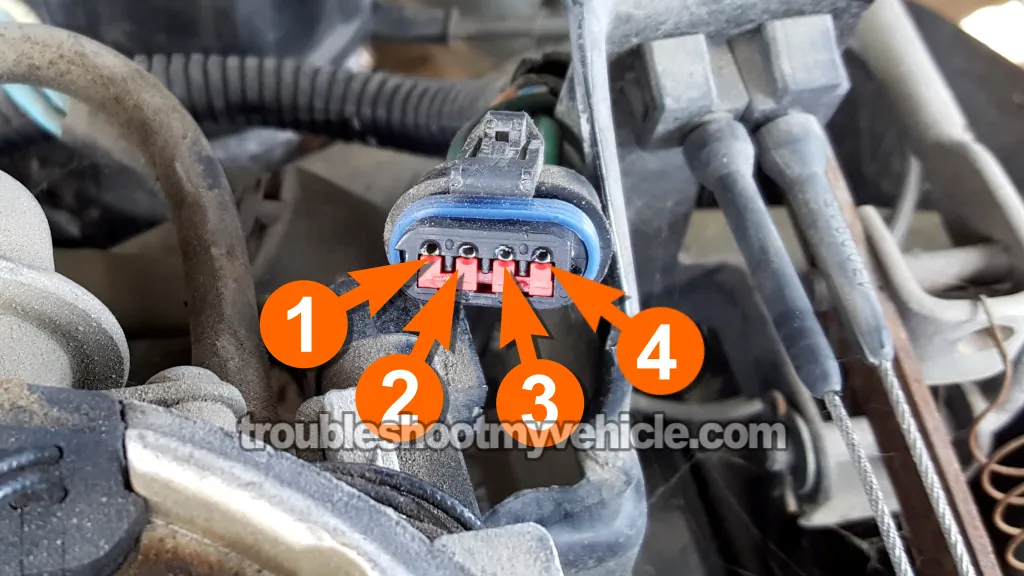TEST 6: Making Sure The Fuel Injector Is Getting An Activation Signal

NOTE: This section only applies if one of the injectors failed to spray fuel during TEST 1.
If you're here, that means you've already confirmed the following:
- TEST 1: One injector sprays fuel; the other does not.
- TEST 3: Both injectors have resistance values within the acceptable range.
- TEST 5: The injector that's not spraying is receiving power.
In this step, we'll check whether the non-spraying injector is getting its activation signal using a simple LED test light.
From experience, I've found that an LED is both the safest option for protecting the fuel injection computer and the easiest tool to detect injector pulse signals.
If you don't have an LED light, you can see what one looks like and you can also buy it here: Oznium Flush Mount 12V LED Light (at: amazon.com).
NOTE: Don't use a regular 12 Volt test light for this test. A 12V test light could overload the fuel injector driver circuit inside the fuel injection computer and fry it.
Let's get started:
- 1
Disconnect the 4-wire fuel injector connector. See the photo above to identify this 4-wire connector.
- 2
Connect the red lead of the LED light to terminal 1 of the 4-wire connector.
NOTE: Make sure that the terminal actually connects to one of the dark green with black stripe (DK GRN/BLK) wires of the connector. - 3
Connect the black lead of the LED light to terminal 2 of the connector.
Terminal 2 should connect to the tan (TAN) wire, which delivers the activation signal for injector #2. - 4
Now, have you helper crank the engine.
CAUTION: Be careful and keep your hands and tools away from any moving parts. - 5
The LED should flash ON and OFF the whole time the engine is cranking.
- 6
Remove the red lead of the LED from terminal 2.
- 7
Now, insert the red lead of the LED in terminal 3.
Terminal 3 should connect to the white with dark blue stripe (WHT/DK BLU) wire, which delivers the activation signal for injector #1. - 8
Now, have you helper crank the engine.
CAUTION: Be careful and keep your hands and tools away from any moving parts. - 9
The LED should flash ON and OFF the whole time the engine is cranking.
Let's interpret your test result:
CASE 1: The LED light flashed ON and OFF for both activation signals. This is the correct test result and confirms that the fuel injection computer is activating the injectors to deliver fuel.
You can conclude that the non-spraying fuel injector is faulty and needs to be replaced if you've already confirmed the following:
- The injector is not spraying fuel (TEST 1).
- The resistance of both injectors is within spec (TEST 3).
- The non-spraying injector is receiving power (TEST 5).
- Both activation signals are present (this test section).
CASE 2: The LED light DID NOT flash ON and OFF on one of the terminals. This means the non-spraying injector isn't receiving its activation signal.
If power is present (confirmed in TEST 5), then the most likely cause of the missing signal is an open-circuit in the activation wire between the injector and the fuel injection computer.
Your next diagnostic step is to check for continuity in the fuel injector wiring between the injector and the FI computer's connector. Fixing this missing activation signal issue should get the injector spraying fuel again.
Tech Tip: Always Replace Injector O-Rings
If you're removing one or both fuel injectors —whether to replace it or simply test it by swapping it out— it's super important that you don't reuse the same O-rings.
Here's why that matters: O-rings are designed to create a snug, leak-proof connection between the injector and its pod (on the throttle body). But once you pull the injector out, those O-rings can easily get damaged —nicked, stretched, or subtly misshapen— even if they appear fine at first glance.
It might seem harmless to reuse them, but doing so significantly increases the risk of a fuel leaks after the engine is shut off.
Play it safe. Here's what you should do:
- Install new O-rings that are specifically designed for your fuel injector and engine type.
- Lightly coat the new O-rings with petroleum jelly to help them slide into place smoothly and reduce the risk of tearing during installation.
It only takes a few extra minutes, but this step can save you from serious headaches down the road.
More 5.2L, 5.9L V8 Dodge Ram Pickup Tutorials
You can find a complete list of diagnostic tutorials for the full-size Dodge Ram pickups in this index:
Here's a sample of the tutorials you'll find in the old index:
- How To Test The Ignition Coil (1989-1991 5.2L, 5.9L V8 Dodge Ram Pickup).
- Throttle Body Temp Sensor Tests (1989-1991 5.2L, 5.9L V8 Dodge Ram Pickup).
- How To Test Engine Compression (1989-2003 5.2L, 5.9L V8 Dodge Ram Pickup).
- Troubleshooting A Blown Head Gasket (1989-2003 5.2L, 5.9L V8 Dodge Ram Pickup).

If this info saved the day, buy me a beer!

